75. Common Deployment Errors – Lessons Learned From Failures (Retail Focus with Cross-Industry Insights)
Digital transformation and AI initiatives promise big rewards for retailers, from streamlined operations to personalized customer experiences. Yet, the road to transformation is perilous – studies show that roughly 70% of these projects fail to fully meet their objectives PENDO.IO . In the retail sector, where margins are thin and customer expectations are sky-high, a botched deployment can be especially costly. This article explores the most common deployment errors in AI and digital transformation, examining their impact and how to mitigate them. Each lesson is illustrated with real-world case studies from retail and other industries, providing a roadmap for business leaders to avoid similar fates. Let’s count down the key reasons transformations fail, and how you can ensure your next big project succeeds.
Q1: FOUNDATIONS OF AI IN SME MANAGEMENT - CHAPTER 3 (DAYS 60–90): LAYING OPERATIONAL FOUNDATIONS
Gary Stoyanov PhD
3/16/202516 min read

1. Lack of Strategic Alignment
1.1 Consequences of a Misaligned Strategy
One of the foremost reasons digital transformations falter is the absence of a clear strategic vision. Deploying advanced AI systems or new ERP software without tying it to a business goal is like setting sail without a destination. The consequences? Wasted investments and aimless efforts. For example, General Electric’s Predix initiative aimed to turn GE into a “digital industrial” leader, but it struggled without a focused roadmap. The company spread resources across too many digital projects with no clear prioritization, ultimately seeing poor returns.
In retail, the downfall of Sears offers a cautionary tale – Sears invested in digital ventures half-heartedly and far too late, without an overarching strategy to compete with e-commerce rivals. The result was fragmented efforts that neither differentiated the brand nor saved it from decline.
In both cases, projects proceeded without answering the vital question: How does this technology move our core business forward? When initiatives aren’t aligned to strategic goals, teams lack direction, success metrics remain fuzzy, and projects drift into failure.
1.2 Ensuring Technology Serves Business Goals
To avoid this error, anchor every tech initiative to a clear business objective. Start with the why: increased market share, enhanced customer loyalty, faster supply chain response – whatever the goal, define it in concrete terms. Successful retailers ensure that each AI or digital project has a business-case ROI and KPIs attached from day one. A great practice is to involve top leadership in crafting and communicating the digital vision. When the C-suite and business unit leaders share a “north star” vision for, say, becoming the most data-driven omnichannel retailer, it guides IT execution at every step. Additionally, perform a strategic fit check: if a proposed project doesn’t clearly support the company’s mission or customer needs, reconsider it. Case in point: when Walmart invested in its online grocery pickup service, it wasn’t just tech for tech’s sake – it directly aligned with a strategy to blend convenience with brick-and-mortar strengths (example of aligning tech with customer convenience). By filtering projects through the lens of strategic relevance, you ensure technology serves the business – not the other way around. This alignment sets the stage for all other aspects of a successful deployment.
2. Inadequate Leadership & Change Management
2.1 The High Cost of Poor Change Management
Even a well-aligned project can fail if people aren’t on board. Change management is the often-undervalued component of digital transformation. Without strong leadership and a plan to manage change, new systems face employee resistance, confusion, and under-utilization. Consider the experience of Procter & Gamble (P&G). P&G’s massive digital overhaul in the 2010s (from marketing digitization to supply chain automation) underperformed, largely because the company underestimated the cultural shift required.
Employees continued to operate in silos and old ways, muting the impact of new digital tools. Similarly, Nokia – once a mobile giant – failed to pivot to smartphone technology not due to lack of tech know-how, but because its leadership couldn’t overcome internal resistance to change and complacency.
These examples show that when leadership doesn’t actively champion the transformation and address fears and habits, the organization’s immune system can reject the change. The cost is not just project delays or budget overruns; it’s lost competitive edge. Promising technology ends up shelved or underused, and the organization falls behind more agile competitors.
2.2 Leading the Change (Culture, Communication, Training)
Avoiding this pitfall starts at the top. Executive sponsorship isn’t a checkbox; leaders must visibly and continually advocate for the transformation. This means crafting a compelling narrative for why the change is needed – and repeating it often. For example, a retail CEO might rally the organization with a vision of becoming “truly customer-centric through data,” making it clear that every employee has a role in that journey. Next, invest in a robust change management plan: identify change champions in each department, set up two-way communication channels (town halls, feedback sessions), and address pain points proactively. Training is non-negotiable – when a new AI tool or software is introduced, provide practical, hands-on training and follow-ups.
One logistics company learned this the hard way when implementing a warehouse automation system: initially, workers bypassed the new system because they weren’t comfortable with it. The company then revamped its approach by involving workers in solution design and ramping up training; adoption surged. The takeaway is clear – people make or break digital transformation. Celebrate quick wins to build momentum, reward teams that embrace new methods, and cultivate a culture that sees change as an opportunity rather than a threat. With leadership driving and empathizing, the organization’s culture transforms alongside the technology.
3. Poor Data Management & System Integration
3.1 When Bad Data Derails Good Tech
In the age of AI, data is king – and a tyrant if mismanaged. Poor data quality and siloed systems are fatal to deployment success. The retail industry has learned that “garbage in, garbage out” is more than a cliché. A famous example is Target’s expansion into Canada. Target invested in new inventory systems for its Canadian stores, but data errors and mismatches between systems led to chronic stockouts and overstocking. Imagine empty shelves where bestsellers should be and backrooms full of unwanted items – that was the reality, fueled by inaccurate data and integration failures.
The fiasco contributed to Target’s decision to pull out of Canada entirely. Another scenario is when AI projects fail because the training data isn’t representative or clean. In healthcare, an AI system designed to assist in diagnoses can give wrong recommendations if the data fed into it is biased or erroneous. We’ve seen AI misfire in credit scoring, retail demand forecasting, even hiring, due to underlying data issues. Integration woes compound this problem: if your new e-commerce platform doesn’t sync with the warehouse database or CRM, you’ll disappoint customers with out-of-stock orders or inconsistent information. In short, neglecting data governance and integration rigor can turn a promising technology deployment into a nightmare of errors and customer complaints.
3.2 Laying a Solid Data Foundation
The solution is to treat data as a strategic asset and integration as a core project pillar. Before deploying fancy algorithms, invest time in data cleanup and consolidation. Retailers should establish a single source of truth for key data like product information, inventory levels, and customer profiles. This might involve creating a centralized data lake or carefully mapping and reconciling data from legacy systems to new platforms. It’s tedious work – much like laying a strong foundation for a skyscraper – but everything built on top relies on it. Take the example of a global retailer that successfully implemented an AI-driven personalized marketing engine. Their secret? Nearly a year spent on merging dozens of customer databases and scrubbing data for accuracy. When the AI went live, it had reliable, rich data to draw on, and the personalization was a hit.
Integration should be approached methodically as well: use middleware or integration platforms to ensure systems communicate seamlessly. Conduct end-to-end tests in a sandbox environment to catch interface issues. Many companies also adopt an iterative integration approach – connecting one module at a time – to isolate and fix issues without jeopardizing the entire operation. The bottom line: great technology cannot overcome bad data or broken integrations. By fortifying data quality, ensuring interoperability, and continuously monitoring these areas, you set your AI or digital project up for real success rather than a data-fueled disappointment.
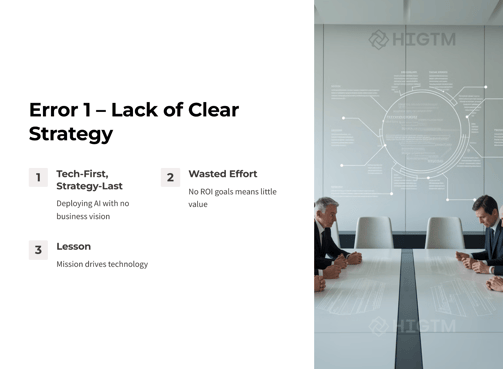

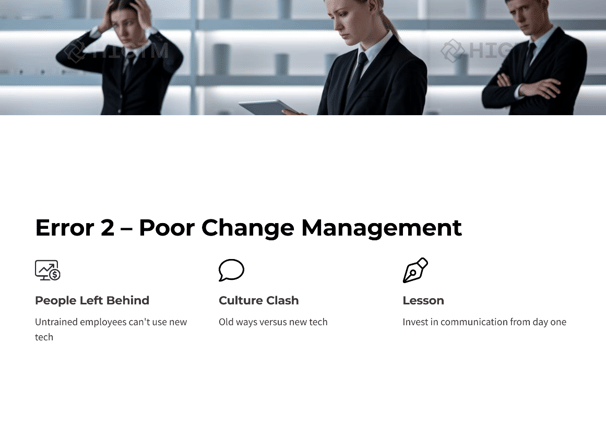

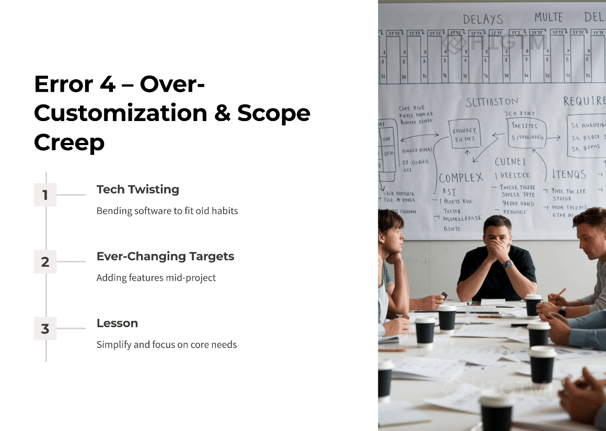

4. Underestimating Complexity & Unrealistic Timelines
4.1 The Perils of Rushing & Oversimplifying
In the fast-paced digital era, speed is often seen as essential – but rushing a transformation can be ruinous. Many projects fail because leaders underestimate the complexity of their undertaking and impose unrealistic timelines. The mentality of “just get it done” leads to cutting corners in design, testing, or training. A classic case is the Hershey’s ERP failure: in 1999, Hershey Foods tried to implement a new ERP, CRM, and logistics system all at once in a tight 30-month window, aiming to go live just before Halloween – their busiest season. The result? Major system glitches that left Hershey unable to deliver $100 million worth of candy for Halloween, a peak sales period.
The culprit was a rushed, overly complex project scope that didn’t allow time to iron out kinks. In another example, the Boeing 737 MAX debacle, although outside retail, serves as a grave warning – Boeing’s rush to update its aircraft software without sufficient testing led to tragic consequences.
In retail, while lives aren’t at stake, a poorly tested system launch can still be catastrophic – think of a new point-of-sale system freezing across hundreds of stores on Black Friday. Underestimating complexity can also mean not realizing how hard it is to change old processes or integrate with dozens of legacy systems. The failure to anticipate these challenges results in blown budgets, missed deadlines, and sometimes public failures that hurt the brand.
4.2 Phasing, Testing, and Realistic Roadmaps
Mitigating this error requires humility and pragmatism in planning. Break big projects into phased deployments. Instead of a “big bang” launch of all features in all locations, a retailer might roll out the new system in a few pilot stores or a single region first. This phased approach was a key to success for many retailers’ omnichannel transformations – they tested click-and-collect in select markets, learned from the hiccups, and only then expanded nationwide. Additionally, build a realistic timeline that factors in the unexpected.
Add buffers for data conversion challenges, vendor delays, or user acceptance testing feedback. Rigorous testing is non-negotiable: conduct integration tests, stress tests (can your new e-commerce site handle a surge of holiday traffic?), and user acceptance tests with real end-users. It’s wise to simulate worst-case scenarios. For instance, before full launch, one Asian e-commerce company ran a “crisis simulation” where one of its key servers was intentionally shut off, to test system redundancy – this exercise revealed weaknesses that they fixed before customers ever felt them. Setting a realistic roadmap also means managing stakeholder expectations.
Explain to executives and board members why a gradual approach is safer, and back it up with data or case studies of failures from going too fast. In summary, treat a digital transformation like a marathon, not a sprint: pace yourself, prepare for hurdles, and you’ll cross the finish line successfully, rather than dropping out injured halfway.
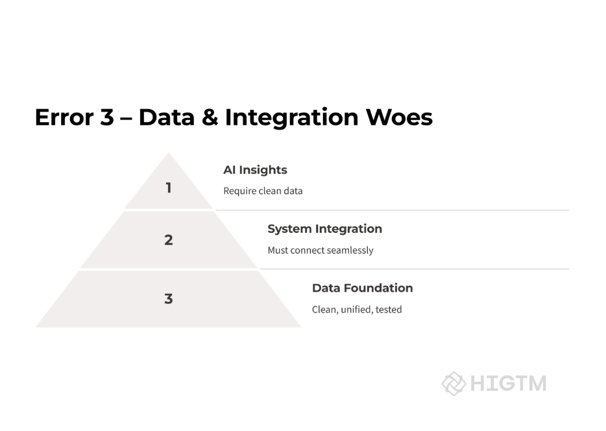

5. Over-Customization and Scope Creep
5.1 When “Have It Your Way” Backfires
Every business is unique, but excessive customization of technology can turn a well-designed product into a tangled mess. Similarly, allowing continuous scope creep – uncontrolled expansion of project goals – often spells doom for transformation efforts. A telling example comes from German retailer Lidl. Lidl embarked on a multi-year journey to implement a new ERP system (SAP) and insisted on tailoring it heavily to match its existing processes (like a unique approach to inventory valuation). This stubborn adherence to old ways in new software led to spiraling complexity and cost. After seven years and roughly €500 million spent, Lidl pulled the plug on the project.
The software was so customized that performance suffered and it became nearly impossible to upgrade or complete. Scope creep is another related menace: it happens when, during the project, stakeholders keep tacking on new requirements – “Wouldn’t it be nice if the system also did X?” – without adjusting timelines or resources. Many ERP and CRM failures can be traced to this “while we’re at it, let’s do more” mentality. The result of unchecked customization and scope creep is predictable: missed deadlines, blown budgets, and an end product that collapses under its own weight (or never goes live at all). It’s the equivalent of trying to customize a race car during the race – you end up with a franken-car that doesn’t reach the finish line.
5.2 Embracing Best Practices and Focused Objectives
The antidote is discipline and trust in modern best practices. Enterprises should carefully distinguish between processes that truly give them a competitive edge and those that are industry-standard. Customize only what makes you special; for the rest, adapt your business processes to the software rather than the other way around. Modern SaaS and enterprise applications come with years of industry best practices built-in. As one IT expert remarked regarding ERP implementations, “If you choose a standard software, adapt your processes to fit it”.
Retailers can take this to heart: do you really need a bespoke checkout process, or can you use the one that’s tried-and-true in your chosen platform? By limiting customization, you also make future upgrades and maintenance far easier. To control scope creep, establish a clear project scope and change control process from the start. Any new feature request should go through a cost-benefit analysis and approval by a steering committee. Often, it’s wise to defer nice-to-have features to a Phase 2 or later. This keeps the initial deployment focused and manageable. Teams using agile methodologies can handle evolving needs in time-boxed sprints, ensuring continuous progress without derailing the overall timeline. In practice, a U.S. retailer adopting a new CRM decided to launch with out-of-the-box features for speed, then used real customer feedback post-launch to guide minor tweaks in subsequent updates. The result was a quick win and a steady evolution, rather than a never-ending project. Remember, simplicity is a strength in transformation. By streamlining and sticking to core objectives, you greatly increase your odds of delivering on time and on value.
6. Insufficient Training & User Adoption
6.1 Technology Left on the Shelf
You can deploy the most advanced AI or system, but if your people don’t use it correctly (or at all), the project is as good as failed. Low user adoption often plagues digital transformation, especially in retail where front-line employees have to embrace new tools while juggling daily customer service. One common scenario: a retailer introduces a sophisticated analytics dashboard for its store managers to optimize local assortments.
However, after launch, it turns out hardly anyone logs in to use it. Why? The managers found it confusing and weren’t comfortable abandoning their trusty spreadsheets. In another case, a global manufacturer implemented collaborative robots (“cobots”) on the assembly line, but workers worked around them initially – they didn’t trust the machines and received minimal training. These examples highlight that without proper training and change management at the user level, new systems become shelfware – utilized well below their potential, if at all. The impact is severe: the expected efficiency gains or revenue boosts don’t materialize, morale can drop (employees might feel the tools are imposed burdens), and sometimes workarounds create new process inefficiencies or security risks. Essentially, the shiny new technology ends up underused, while old practices persist – an expensive failure of execution.
6.2 Driving Adoption Through Engagement and Support
Achieving strong user adoption starts with inclusive design and communication. Long before go-live, involve the end-users in the process. For instance, if you’re rolling out tablets for in-store associates, get a group of associates to pilot them and provide feedback on the interface and features. This not only improves the solution (making it more user-friendly) but also creates internal champions who can evangelize the tool to peers. Next, invest heavily in training – and think beyond one-off sessions. Effective training is continuous: initial hands-on workshops, easy-to-follow user guides or video tutorials, and on-demand help (like a hotline or chat support) for the first critical weeks. Gamification can help too; some companies run friendly competitions or reward early adopters who use the system effectively. Another key strategy is to tie usage to performance where appropriate.
If the new CRM is directly linked to sales commissions, ensure the sales team knows how their input (or lack thereof) will impact them. Often, demonstrating quick wins is the best motivator: for example, show the store managers that using the new analytics tool can pinpoint slow-selling inventory to mark down, which improves their KPIs. When they see personal benefit or easier workdays thanks to the new system, they’ll embrace it. Finally, leadership should reinforce the change – celebrate teams or individuals who’ve made effective use of the new technology, and gently but firmly require accountability for using the tools provided. In summary, technology adoption is achieved by making users partners in the journey, equipping them with knowledge, and continuously supporting and incentivizing them until the new way of work becomes the norm.
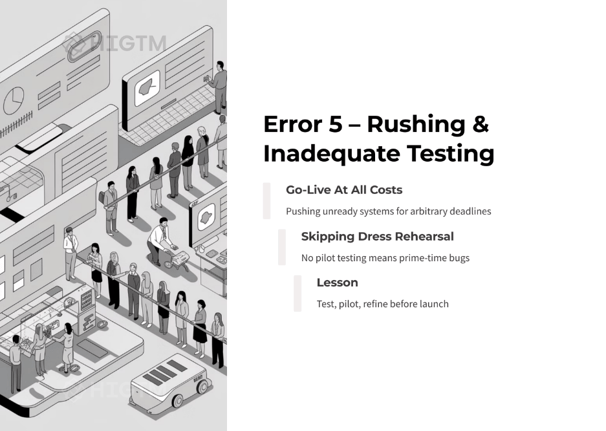

7. Neglecting Customer Experience and Feedback
7.1 When Digital Transformation Forgets the Customer
In the rush to modernize operations and implement AI, companies sometimes become inward-focused, optimizing processes or cutting costs but overlooking the customer experience. This is a critical error: if the end result of your transformation doesn’t delight your customers (or worse, alienates them), the initiative can backfire spectacularly. The retail graveyard is filled with examples. Take British Home Stores (BHS) in the UK – while not an AI failure per se, BHS infamously neglected e-commerce and digital engagement, sticking to old retail models. Customers moved on, and the chain couldn’t attract a new generation of shoppers, contributing to its demise.
On the flip side, introducing new tech can also upset customers if mismanaged. Remember the early days of automated checkouts? Some supermarkets rolled them out without considering customer preferences, leading to frustration with machines that were confusing or malfunctioning – customers felt like guinea pigs for unproven tech. In the AI realm, consider when companies have deployed chatbots or recommendation engines. If the chatbot cannot answer common questions or the AI recommendations feel creepy and intrusive, customers will disengage or complain. A poignant example is Mattel’s “Hello Barbie” incident: this Wi-Fi connected doll had AI conversations with kids. The idea was innovative, but it raised serious privacy concerns and many parents saw it as a violation of trust.
Sales flopped and Mattel faced a PR headache. When transformation efforts erode trust or degrade the user experience, the damage can include loss of customers, bad press, and even regulatory scrutiny in cases of privacy breach.
7.2 Keeping the Customer at the Core
The guiding principle to prevent this error is simple: customer-centricity. Every major digital initiative should be filtered through the lens of “How does this impact our customers?” If a new system is internal (say, inventory automation), think of its indirect effects on customers (fewer stockouts, faster deliveries?). For customer-facing innovations (mobile apps, AI chatbots, personalization engines), involve customers in the design and testing. Retailers increasingly use customer focus groups or beta programs – for example, a fashion retailer launching a new augmented reality fitting room first invited loyalty customers to try it and give feedback, iterating the experience before a public launch. Additionally, maintain multiple feedback channels once a new technology is live.
Encourage customers to rate their experience with the new e-commerce interface or to report issues with the new self-service kiosks. Analyze that feedback religiously and respond quickly – if shoppers hate a new feature, be ready to adjust or even roll it back. Privacy and ethics deserve special attention in AI deployments. Ensure transparency with customers about how AI is used (say, in recommendations or pricing) and give them control where appropriate (such as opting out of AI-driven suggestions). A bank that introduced an AI-driven credit scoring had an ethics board review the algorithm for bias, and openly communicated to customers how decisions were made, to build trust.
Finally, remember that the best digital strategies blend tech with the human touch. For instance, chatbots are great for 24/7 quick answers, but always offer a handoff to a human for complex issues – customers appreciate having that choice. By making customer experience improvement the North Star of your transformation, you not only avoid missteps but actively strengthen your brand. After all, a transformation that customers love is one that yields the highest rewards.
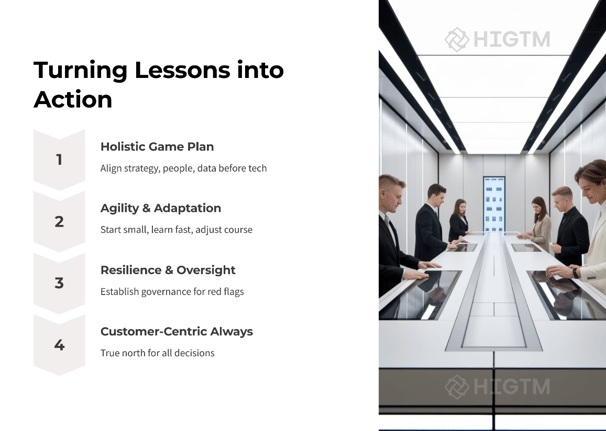



8. Lack of Continuous Improvement & Governance
8.1 Stagnation After Implementation
Imagine declaring victory the day a new system goes live – and then moving on as if the journey is over. This happens far too often: companies treat digital transformation as a one-time project that’s “completed,” and they fail to continuously improve or govern the new processes and technologies. The consequence is that systems gradually become less effective or even fall into disuse. In retail, an example might be a chain that launched a mobile app with great fanfare and initial success, but then did not update it for years. Over time, customers found it outdated compared to competitors’ apps, and usage dwindled. In another case, a multinational implemented a powerful analytics platform enterprise-wide. However, without ongoing governance, data quality issues crept back in, different departments created conflicting reports, and soon management lost trust in the numbers again – essentially back to square one despite the fancy tool.
A historical example from the public sector is the UK’s NHS (National Health Service) digital program in the 2000s: after initial deployments struggled, a lack of iterative correction and on-the-ground feedback meant issues weren’t resolved, and the program was eventually scrapped after massive expenditures. When organizations lack a mindset (and structures) for continuous improvement, they risk the “launch and leave” scenario – where the transformation doesn’t evolve with changing needs and slowly fails. Moreover, without proper governance, things like user permissions, security updates, process compliance and performance metrics can slip, leading to breakdowns or vulnerabilities over time.
8.2 Iteration, Measurement, and Adaptation
Successful digital transformers know that go-live is just the beginning of a new phase. To truly realize benefits, you need to monitor, refine, and enhance your solutions regularly. Establish a governance team or “Center of Excellence” to own the ongoing success of the deployed technology. For instance, after implementing AI in merchandising, a retailer set up an AI oversight committee to continuously track key metrics (forecast accuracy, stock levels, sales lift) and make adjustments to algorithms and processes each season. This kept performance improving year over year. It’s crucial to define KPIs and success metrics at the start of a project and keep measuring them post-implementation. If targets are not met, treat it as a feedback loop – investigate why, and take corrective action. Embrace an agile mindset: many companies now use DevOps teams to continuously update software or processes in short cycles.
A practical example is how e-commerce leaders deploy improvements to their website and apps weekly or even daily based on user analytics and A/B testing results. That level of iteration might be ambitious for everyone, but the concept of frequent enhancements is widely applicable. Also, create channels for employee and customer feedback on the new system; front-line users will often be the first to spot issues or new opportunities. By hearing them and responding, you not only fix problems early but also build user buy-in (they see that the system is evolving to serve them better). In governance terms, ensure there are owners for data quality, security, and process compliance continuously – transformations can introduce new risks, so assign responsibility to manage these areas long-term. In summary, treat your digital transformation like a living product: nurture it, tweak it, and grow it over time. This way, you turn a one-time project into a sustained success story that continues to deliver value and stays relevant as the business and environment change.
Conclusion
The journey of digital transformation in retail (and any industry) is challenging, but it’s navigable with the right approach. The common errors we’ve discussed – from missing a clear strategy to neglecting the people and customers involved – have been the downfall of many projects. Yet, in each failure lies a lesson. Retailers can take heart that they don’t need to reinvent the wheel; the pitfalls are now well-known, and so are the remedies. The overarching theme is balance: balance technology with strategy, innovation with cultural change, speed with diligence, and efficiency with customer empathy. A successful AI or digital deployment is one where all these elements align.
By planning thoroughly, involving leadership and front-line alike, investing in data and training, and staying agile post-launch, businesses can significantly tilt the odds in favor of success. Remember that transformation is not a one-time leap but an ongoing voyage – one that can lead to tremendous growth, market leadership, and new capabilities that delight customers. With transparency, courage, and the lessons of those who went before, you can ensure your digital transformation doesn’t become just another statistic, but rather a shining example of what’s possible when technology and business acumen unite. Here’s to learning from the past and boldly building the future. 🚀
Turn AI into ROI — Win Faster with HIGTM.
Consult with us to discuss how to manage and grow your business operations with AI.
© 2025 HIGTM. All rights reserved.
